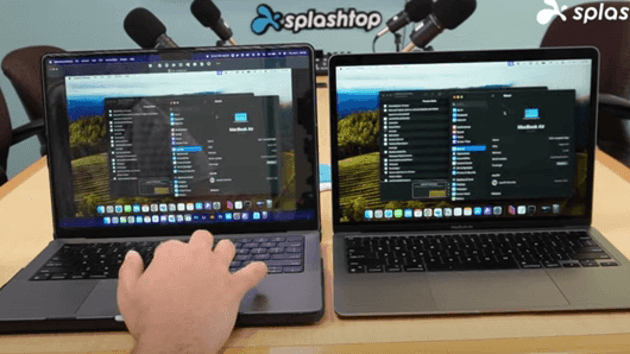
Remote support software has revolutionized the IT support industry. IT, service desk, MSP, and help desk professionals have all enjoyed many benefits from using a remote support tool, including improved customer satisfaction, quicker turnaround times, and even reduced costs.
So what exactly is remote support software? How does it work? And what is the best solution for your organization? Read on to get all the answers you need.
What is Remote Support?
Remote support is a technology that enables IT technicians to access another computer or device remotely to provide support. The remote connection allows the technician to see the screen of the remote device on their own screen in real-time, and in most cases be able to take control of the remote device to troubleshoot issues and perform other tasks.
How Does Remote Support Work?
Remote support leverages remote access (or remote desktop) software to give the technician instant access to the remote device from anywhere, at any time. This means that they can provide remote assistance without having to travel to the device.
While in a remote session, the technician can take control of the device and perform whatever task is needed. They can install updates, resolve issues, and perform maintenance. Most remote support solutions come equipped additional features that help IT pros be more productive while providing remote support. Examples include file transfer, remote print, chat, session recording, screen sharing, and more.
By being able to remotely access a device to provide support, IT support teams, help desks, and managed service providers can resolve support tickets quicker. This means they can save time and get more done throughout the day. End-users receiving support enjoy faster service which leads to increased satisfaction.
Types of Remote Support
Remote support software can generally be sorted into three categories:
Unattended remote support
Attended remote support
Remote support through screen viewing
The difference between attended vs unattended remote support is determined by whether an end-user is present on the remote device while the IT technician is providing remote assistance. The functionality of each type of solution differs as well.
1. Unattended: Remote Support Without an End-User
Unattended access means the technician can remotely connect to the endpoint device even without an end-user present. Remote support platforms make this possible by having the IT team deploy an agent app on all the computers they manage. Once the agent is installed, a member of the IT team can to connect to the remote computer they want to access.
By having the agent installed on the remote computer, IT technicians are able to remotely access the computers at any time, with or without someone actively using the computer. This makes it possible to support computers outside of regular office hours or when the endpoint is not in use.
2. Attended Remote Support
Also known as on-demand support, or ad-hoc support, attended support allows technicians to access a device the moment the end-user requests assistance. Once connected, the technician can provide support to resolve the issue.
Unlike with unattended access, there is not prior setup necessary for attended access. Because an end-user is present, they are able to help the technician establish a remote connection to their device. This can be done a variety of ways, but a common method is to have the end-user run the remote support tool’s app to generate a unique session code, which the user gives to the technician so they can connect to the device and take control.
Attended access enables help desk professionals to provide support to any device as long as the end-user is present. This means they can remotely support managed devices as well as personal devices.
3. Remote Support Through Screen Viewing
Remote support through screen viewing allows support technicians to view the screen of the user's device without having direct control over it. This method is particularly useful for providing guidance and troubleshooting on devices where remote control is restricted or not possible. One prominent example is providing remote support for iOS devices.
Technicians can visually guide users through the steps to resolve issues, ensuring clear communication and effective troubleshooting. Since technicians do not have control over the device, there is a lower risk of unauthorized actions or data breaches.
This method adheres to platform restrictions, such as those on iOS devices, where remote control is not allowed. Due to Apple's security policies, remote control of iOS devices is restricted. However, remote screen viewing allows support technicians to see the user's screen and provide real-time assistance. This can be particularly beneficial for resolving software issues, configuring settings, and providing training on app usage.
By incorporating remote support through screen viewing into your support strategy, you can extend your capabilities to a wider range of devices and ensure that all users receive the help they need, regardless of the platform they are using.
Use Cases of Remote Support
Remote desktop support is used in a wide range of IT and business scenarios:
IT Helpdesk Services: Support teams can quickly resolve end-user issues without needing to be physically present.
MSPs and IT Service Providers: Managed service providers rely on remote support to deliver scalable and efficient IT assistance across clients and locations.
Remote Work Support: Companies use remote support tools to troubleshoot employee devices and ensure business continuity in remote or hybrid setups.
Education and Training: Educators and IT admins can remotely access and control student or faculty devices for configuration, support, or demonstrations.
Software Deployment and Updates: IT teams can install patches, updates, or applications across multiple endpoints remotely.
Challenges in Ensuring Reliable Remote Technical Support
Despite its advantages, remote technical support can face several challenges:
Connectivity Issues: Poor or unstable internet connections can interrupt sessions and delay problem resolution.
Security Risks: Without strong access controls and encryption, remote sessions may expose sensitive systems to unauthorized access.
User Resistance: Some end users may be hesitant to grant access or lack the technical knowledge to follow the setup steps.
Device Diversity: Supporting different operating systems and hardware types can complicate remote troubleshooting.
Scalability: As teams grow or support needs expand, it becomes difficult to manage sessions and devices without the right infrastructure.
Best Practices for Remote Support: Ensuring Secure & Seamless IT Assistance
To deliver reliable, secure, and high-quality remote support, consider these best practices:
Use Secure Remote Support Software: Choose tools like Splashtop that offer end-to-end encryption, role-based access controls, and multi-factor authentication.
Implement Access Policies: Define who can access what devices and when. Use logging and session monitoring for oversight.
Train Technicians and End Users: Ensure support teams are well-versed in the software, and educate users on what to expect during a session.
Prepare for Multiple Platforms: Use software that supports all major operating systems, ensuring technicians can help regardless of device type.
Monitor and Optimize Performance: Track session metrics, resolution times, and common issues to continuously improve service quality.
Top Advantages of Using Remote IT Support for Your Business
Remote IT support has revolutionized the way businesses handle technical issues and maintenance, enabling support teams to assist users from anywhere at any time. This approach ensures that troubleshooting and system maintenance are no longer confined to physical locations, allowing for quick and efficient resolution of problems.
The benefits of remote IT support are numerous:
Increased Efficiency: Technicians can resolve issues faster without the need for on-site visits.
Cost-Effective: Reduces travel expenses and downtime, leading to significant cost savings.
Flexibility: Support teams can provide assistance from any location, ensuring uninterrupted service.
Improved User Experience: Users receive timely help, reducing frustration and increasing satisfaction.
24/7 Availability: Remote support can be offered round the clock, catering to global teams and different time zones.
By leveraging remote IT support, businesses can maintain smooth operations, enhance productivity, and deliver exceptional service to their users.
10 Key Features of Remote Support Software
When selecting remote support software, it's crucial to look for features that enhance efficiency, security, and user satisfaction. Here are ten key features to consider:
Cross-Platform Support: Ability to provide remote support across various operating systems including Windows, macOS, Linux, iOS, and Android. This ensures that support teams can assist users regardless of the device they are using.
Unattended Access: Allows technicians to access remote devices even when the user is not present. This feature is essential for off-hours maintenance, updates, and troubleshooting.
Real-Time Screen Sharing: Enables technicians to view and interact with the user's screen in real time. This feature is critical for providing accurate support and quickly resolving issues.
File Transfer: Securely transfer files between the support technician's and the user's devices. This is useful for sending patches, updates, or retrieving log files for diagnostics.
Chat and Communication Tools: Integrated chat functionality allows for clear communication between the technician and the user.
Session Recording: Record support sessions for training, quality control, and audit purposes. This feature ensures that interactions are documented and can be reviewed if necessary.
Multi-Session Handling: Ability to manage multiple support sessions simultaneously. This is particularly useful for support teams handling a high volume of requests.
Customizable Branding: Customization options to add company branding to the remote support interface. This helps in maintaining a professional appearance and instills trust in users.
Security and Compliance: Robust security features including encryption, two-factor authentication, and compliance with industry standards (such as GDPR and HIPAA). Ensures that user data is protected and privacy is maintained.
Remote Viewing for iOS Devices: Due to iOS restrictions, remote control is not possible. However, the ability to view the screen allows technicians to guide users through troubleshooting steps effectively.
These features collectively contribute to a comprehensive remote support solution that can address various technical issues efficiently and securely. By choosing a remote support software with these capabilities, businesses can ensure high-quality support and enhance overall user satisfaction.
(See: Top 5 Remote Support Software Must-Have Capabilities)
Selecting the Ideal Remote PC Support Software for Your Organization
Choosing the right remote support software is crucial for ensuring efficient and effective IT support. Here are key factors to consider:
Ease of Use
Opt for software that offers an intuitive and user-friendly interface. This minimizes the learning curve for support staff and ensures that users can easily access and utilize the support features. Simple setup and navigation are essential for maximizing productivity and reducing downtime.
Cost-Effectiveness
Evaluate the pricing structure to ensure it aligns with your organization's budget. Consider the total cost of ownership, including subscription fees, setup costs, and potential savings from reduced travel and downtime. Cost-effective solutions should provide robust features without compromising quality.
Platform Versatility
Ensure the software supports a wide range of operating systems and devices, including Windows, macOS, Linux, iOS, and Android. This versatility is essential for providing comprehensive support to all users, regardless of the device they are using.
By prioritizing these factors, you can select a remote support software that meets your organization's needs and enhances overall IT support efficiency. For additional info, see our Remote Support Buyer's Guide.
Which Splashtop Remote Support Solution is Right for You
Your use case will determine what type of solution you need. Here are the top remote support software tools by Splashtop, the leader in reliable and secure remote support solutions at the best value.
For IT, help desks & MSPs – Splashtop Remote Support
For Enterprises – Splashtop Enterprise
1. Best Remote Support Software for MSPs – Splashtop Remote Support
Splashtop Remote Support is primarily an attended and unattended support solution, with additional remote monitoring and management features that are essential to MSPs. This is the ideal remote support tool for IT, help desks, and MSPs because:
You’ll only pay for the number of unattended devices you want to support. Unlimited technicians.
No forced upgrades or price increases
Easy deployment and easy to scale
Remote access from any device (Windows, Mac, iOS, Android, and Chromebook)
Fast connections powered by a high performance engine
Robust security and end-to-end encryption to keep all sessions safe
User and computer management console where you can manage groups, add admins, set permissions, and more
Useful features such as file transfer, remote print, chat, remote wake, and more
Additional monitoring and management features such as event logs, remote command, Scripts and Tasks, configurable alerts, and more
Learn more about Splashtop Remote Support and try it for free today!
2. Best Remote Support Software for Enterprises – Splashtop Enterprise
Splashtop Enterprise is an all-in-one remote access and remote support solution. With it, your IT team can remotely support your devices with unattended remote access. Plus, you can enable your internal users to remotely access their office computers for remote work and work from home purposes.
Splashtop Enterprise is ideal because:
You’ll get one solution that solves all your remote access needs
SSO/SAML (single sign-on) integration available
Both unattended and attended access capabilities available
Easy to deploy and scale. Highly secure with end-to-end encryption and advanced security features
On-premise option available
Learn more about Splashtop Enterprise, and get in contact with us to find out more!
Get Started with Splashtop Remote Computer Support Software
Splashtop has been in the remote access industry for over a decade, with a focus on making remote access and remote support reliable, accessible, and secure at the best value. That’s why over 30 million people use Splashtop, and why Splashtop solutions are consistently rated as the best remote access and remote support tools by third-parties and peer-to-peer review sites.
See all Splashtop solutions.




